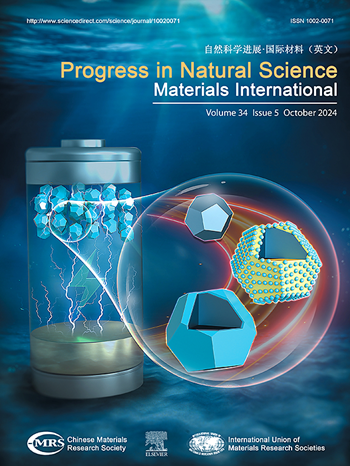Ultrafast synthesis of highly graphitized carbon foams through water explosion method
IF 7.1
2区 材料科学
Q2 MATERIALS SCIENCE, MULTIDISCIPLINARY
Progress in Natural Science: Materials International
Pub Date : 2024-12-01
DOI:10.1016/j.pnsc.2024.10.001
引用次数: 0
Abstract
In recent years, carbon foams have attracted considerable attention due to their distinctive physical and chemical properties, including high specific surface area, excellent electrical conductivity, and robust chemical stability, which render them highly suitable for applications in energy storage, catalysis, and adsorption. However, conventional carbon foams are limited by low levels of graphitization and a lack of long-range structural order, restricting their use in high-performance applications. Traditional synthesis methods, such as templating, chemical activation, and hydrothermal processes, although effective in forming porous structures, are complex and inefficient. To overcome these limitations, this study introduces a novel one-step water explosion method that combines Joule heating and steam activation to synthesize highly graphitized porous carbon foam. By rapidly vaporizing intercalated water molecules between graphite layers, the method overcomes van der Waals forces, leading to the exfoliation of the material. The process, conducted under ultra-high temperatures in less than 1 s, produces carbon foam with high porosity, large surface area, and excellent electrochemical performance. In lithium-ion battery tests, the carbon foam exhibited a high capacity of 516.2 mAh/g at 0.1 A/g and retained 92.77 % of its capacity after 1100 cycles. This efficient and scalable synthesis technique offers a promising pathway for the development of advanced anode materials in energy storage applications, significantly outperforming conventional graphite-based materials.
水爆法制备高石墨化泡沫碳的超快合成
近年来,泡沫碳材料以其独特的物理和化学性质引起了人们的广泛关注,包括高比表面积、优异的导电性和强大的化学稳定性,使其非常适合应用于储能、催化和吸附等领域。然而,传统的泡沫碳受到低石墨化水平和缺乏长期结构秩序的限制,限制了它们在高性能应用中的应用。传统的合成方法,如模板法、化学活化法和水热法,虽然在形成多孔结构方面是有效的,但却复杂而低效。为了克服这些限制,本研究引入了一种新的一步水爆炸方法,该方法结合焦耳加热和蒸汽活化来合成高度石墨化的多孔泡沫碳。通过快速汽化石墨层之间嵌入的水分子,该方法克服了范德华力,导致材料脱落。该工艺在不到1 s的超高温下进行,生产出的泡沫碳具有高孔隙率、大表面积和优异的电化学性能。在锂离子电池测试中,泡沫碳在0.1 a /g下表现出516.2 mAh/g的高容量,并且在1100次循环后保持了92.77%的容量。这种高效且可扩展的合成技术为开发储能应用中的先进阳极材料提供了一条有前途的途径,显著优于传统的石墨基材料。
本文章由计算机程序翻译,如有差异,请以英文原文为准。
求助全文
约1分钟内获得全文
求助全文
来源期刊
CiteScore
8.60
自引率
2.10%
发文量
2812
审稿时长
49 days
期刊介绍:
Progress in Natural Science: Materials International provides scientists and engineers throughout the world with a central vehicle for the exchange and dissemination of basic theoretical studies and applied research of advanced materials. The emphasis is placed on original research, both analytical and experimental, which is of permanent interest to engineers and scientists, covering all aspects of new materials and technologies, such as, energy and environmental materials; advanced structural materials; advanced transportation materials, functional and electronic materials; nano-scale and amorphous materials; health and biological materials; materials modeling and simulation; materials characterization; and so on. The latest research achievements and innovative papers in basic theoretical studies and applied research of material science will be carefully selected and promptly reported. Thus, the aim of this Journal is to serve the global materials science and technology community with the latest research findings.
As a service to readers, an international bibliography of recent publications in advanced materials is published bimonthly.

 求助内容:
求助内容: 应助结果提醒方式:
应助结果提醒方式:


